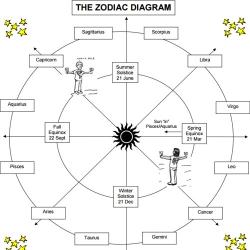Source Institutions
Source Institutions
Add to list Go to activity
Activity link broken? See if it's at the internet archive

Through a series of simple body movements, learners gain insight into the relationship between time and astronomical motions of Earth (rotation about its axis, and orbit around the Sun), and also about how these motions influence what we see in the sky at various times of the day and year. This activity can be used to introduce seasons on Earth and other planets. Learners will especially enjoy finding their birthdays in the orbit and using a zodiac diagram. This comprehensive lesson plan includes detailed background information, common misconceptions, extensions, teacher tips, references/resources, and FAQs.
- 30 to 45 minutes
- 2 to 4 hours
- $5 - $10 per group of students
- Ages 11 - adult
- Activity, Lesson/Lesson Plan, Simulation
- English
Quick Guide
Materials List (per group of students)
- spherical object the size of a large grapefruit (14-in diameter for scale model Sun)
- ball point pen or pencil (tip is for scale model Earth)
- object to represent the Sun at the center of the circle (a lofting helium balloon is ideal)
- 12 Zodiac Signs with instructions for assembly and set-up
- masking tape (optional)
- orion constellation (optional)
- sphere to show the distribution of continents on planet Earth (globe or inflatable Earth)
- t-shirt with North & South America on the front and Asia & Australia on back (optional)
- birthday or party hat (optional, but a simple and fun enrichment)
- 4 Seasons Signs with dates of equinoxes and solstices
- flashlight or light source that projects a bright beam of light (optional)
- “E” and “W” cards [one pair for each learner)
- Assessment materials as desired
Subjects
-
Earth and Space Science
-
Astronomy
- Stars and Galaxies
-
Earth, Moon and Sun
- Days
- Seasons
-
Solar System
- The Sun
- The Moon
- The Planets
-
Astronomy
Informal Categories
- Outdoor Activity
- Physical Activity
Audience
To use this activity, learners need to:
- see
- read
- be mobile
- touch
Learning styles supported:
- Involves teamwork and communication skills
- Involves hands-on or lab activities
Other
Components that are part of this resource:
Includes alignment to state and/or national standards:
Includes assesments for student learning:
This resource is part of:
Access Rights:
- Free access
By:
- Morrow, Dr. Cherilynn A. ; Zawaski, Michael
Rights:
- All rights reserved, Dr.Cherilynn A. Morrow and Michael Zawaski, 2004
